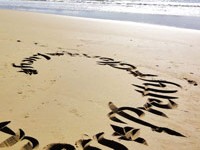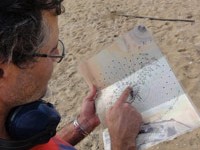Andrew van der Merwe
The making of a mark – from art to the written word, is a basic tool of communication. Understanding these marks is key to literacy – whether, for example, a circle symbolises a face or the number zero. Van der Merwe is one of South Africa’s leading calligraphers and has developed one of the most in-depth repertoires of mark making in South Africa. Van der Merwe has always played with sticks, scratching the sand with them. As his skill in lettering increased, so did his dissatisfaction with the types of marks he was able to create in sand. In response he fabricated a specialised tool kit to enable him to engrave into the sand. Relishing the physical nature of drawing in the sand, as opposed to his normal practice of writing with a nib on paper, Van der Merwe writes in sand at about the same speed he would normally write on paper. A visual artist of the written word, van der Merwe uses his beach calligraphy to question our literacy. He uses forms that have the characteristics of writing, but the strokes do not form known letters. Called Asemic writing, the reader deduces meaning not by way of the content, but rather through the form and structure of the text. The gestures in the letter-like symbols and the composition of the piece as a whole give a sense of the artist’s intention. If you ask Van der Merwe how he creates his sand drawings without creating a footprint, he replies: “I levitate”.
In both his contributions to Site_Specific, Van der Merwe draws our attention to the existence of an intrinsic pattern or meaning that is beyond our immediate understanding. Mathematics is a rich, descriptive language which can portray the world around us. In its simplicity and descriptive elegance it holds the potential for beauty.
Named after the man who also introduced Arabic numerals to Europe in the Middle Ages, the Fibonacci sequence, describes a number that is the sum of the previous two numbers. It begins with 0 then 1. Logically, the integers follow as: 1, 2, 3, 5, 8, 13, 21, 34, 55, 89, 144, 233, 377, 610, 987, and so on. This sequence is common in nature, such as the pattern found in the head of a sunflower.
Van der Merwe utilised the Fibonacci sequence to configure an arrangement of poles. Viewed from the centre they appear to be random – no poles form a line – yet one discovers the graceful arcs as one moves through the installation.
The best view of this pattern was fortuitously from Van der Merwe’s hotel room on the 5th floor of the Beacon Island Hotel. From this vantage point one not only sees the regularity in the placement of the poles, but also the pattern of movement. The passers-by’s footprints on the sand add another layer to this installation.



